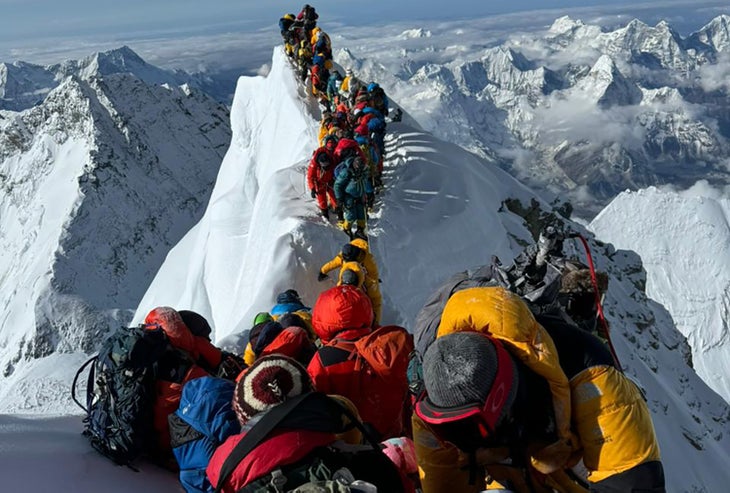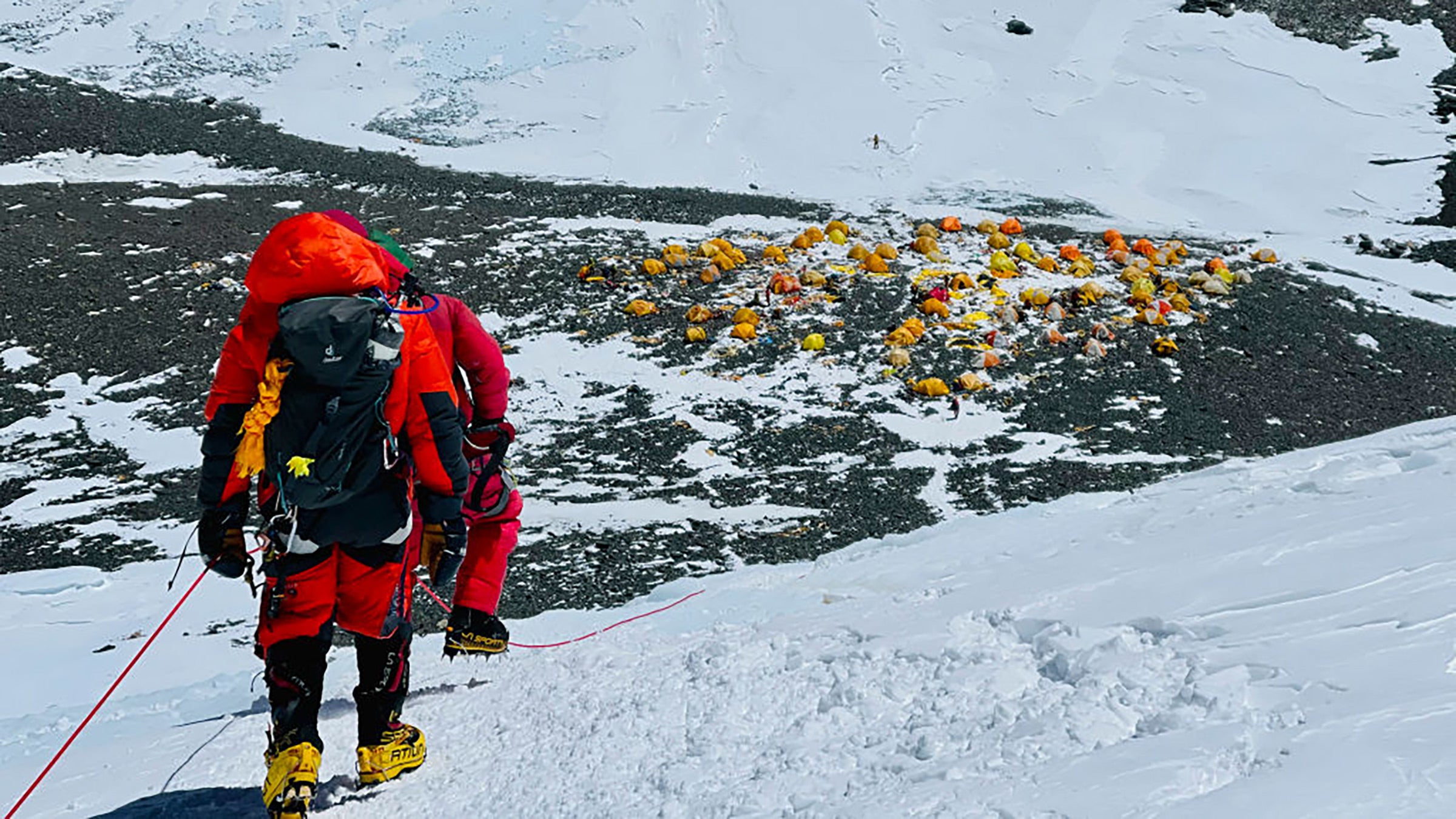The spring climbing season on Mount Everest came to an official close in late May when monsoons once again crept up the Khumbu Valley and shrouded the world’s highest peak in clouds.
The world’s highest peak saw both ambitious climbers breaking new records and images of conga lines clogging the summit ridge this year. But this season’s most notable statistic may be the dramatic downturn in fatalities from the record high in 2023. Nine climbers perished or went missing in 2024, down from 18 a year ago. Why? Experts cannot agree on one specific reason.
Government officials confirmed six deaths during the season, and three others are considered “missing,” however they are presumed to be deceased. The downturn in fatalities came amid a busy year on the peak. According to Rakesh Gurung, managing director of Nepal’s Department of Tourism, the agency issued 421 permits to foreign climbers in 2024—down from 478 last year—and approximately 600 people reached the summit, between climbers, high-altitude guides, and other mountain workers.
What Made Everest Less Deadly This Year?
Gurung attributes the decrease in deaths to new safety regulations imposed by regional Nepali lawmakers—rules that required —as well as to greater oversight by government officials. “Recognizing the tendency for climbers to push their limits despite deteriorating health at high altitudes, field officers actively engaged with climbers at various camps, emphasizing the importance of safety measures,” he told ���ϳԹ���. “There was a heightened sense of vigilance and caution among guides and operators.”
Yellow band on Mt Everest (8848.86 m), 20.05.2024. Video ©: Rajan Dwivedi.
— Everest Today (@EverestToday)
Expedition operators told ���ϳԹ��� that there is some truth to Gurung’s perspective.
Thaneswhar Guragai, general manager of Seven Summit Treks, believes the tragic deaths in 2023 forced Nepali expedition operators to boost safety measures this year. Some forbade clients who were unprepared from venturing to the summit, he said.
“This year the Nepali companies are more cautious about their reputation. If the climber and the guide are not ready, they won’t send them up to the summit,” he told ���ܳٲ������.��“When the situation is not ready, it’s not like in the past when they would still send the clients. If the client decides to go up, we will stop them and bring them back.”
But others pushed back on Gurung’s assertion that the government’s new safety protocols had a dramatic change. “I never saw the Recco system in anyone’s clothing or gear, and I don’t think it would help,” said American guide Garrett Madison.
Did Weather Impact Safety?
Instead, Madison and Guragai pointed to the weather on Everest for creating safer conditions in 2024 than last year. In 2023, temperatures plunged well below freezing during the two-week climbing window, and climbers had to battle extreme cold for most of the ascent. In 2024, some climbers reached the summit wearing baseball caps.
This year climbers enjoyed an early weather window, and several dozen reached the top on May 13. But then high winds and snowfall descended on the peak, pushing the majority of climbing teams to summit when the weather cleared on May 21st. Huge crowds formed on the fixed ropes in the days after, but those climbers enjoyed clear skies and warm temperatures.
“Overall the 2024 season was much warmer than the 2023 season,” Madison said. “So it seemed like less people got sick from colds, viruses, etc, and there were fewer weird fatalities.”
Bili Bierling, manager of the website, Himalayan Database, which tracks ascents on 479 peaks in Nepal, believes climbing teams may have also benefitted from a more intangible factor: good fortune. “The conditions and the weather were very stable this year—the number of deaths is sometimes pure luck, sometimes the conditions,” she said.
Everest Season Still Wasn’t Perfect
But this spring was far from flawless, and nine deaths is still higher than the annual death total in recent years. According to The Himalayan Database, three people died on Everest in 2022, while five died in 2021, 11 perished in 2019, and five died in 2018. Austrian guide Lukas Furtenbach believes most of the fatalities this year were preventable and could have been avoided with “regulations, uniform minimum standards and mandatory safety protocols.”

One rule guides proposed was limiting climbers from scaling the peak without using supplemental oxygen. Of the nine dead, four were climbing without the use of supplemental oxygen. Mongolian climbers, Usukhjargal Tsedendamba, 53, and Purevsuren Lkhagvajav, 31, were found just below the summit. According to Bierling, who tracks climbers on the 8,000-meter peaks, neither man had previous climbing experience in Nepal, and both were attempting the peak without supplemental oxygen. A Kenyan climber named Cheruiyo Kirui, 40, also died near the summit while climbing without oxygen—his guide, Nawang Sherpa, has yet to be found. And Romanian climber Gabriel Tabara, 48, was found dead in his tent while attempting to ascend 27,940-foot Lhotse without oxygen.
“There could be a minimum amount of oxygen cylinders for each person, also no solo climbing, clients of guided expeditions are at no point on the mountain left alone and many other basic things,” Furtenbach wrote to ���ϳԹ���. “Fourteen of 18 from last year and six of nine from this year died because of a lack of oxygen at some point above Camp III.”
Two other fatalities were also preventable: Pas Tenji Sherpa and his client Daniel Paul Paterson fell to their deaths when an ice cornice collapsed. The two had unhooked themselves from the fixed ropes to navigate a traffic jam on the summit ridge when the accident occurred.
Records Tumble Across the Himalayas
Climbers set several ascent records on Everest in 2024, with notable expeditions completed by Nepali climbers. Photojournalist Purnima Shrestha became the first woman to summit three times in a single season, and Dawa Finjok Sherpa, also of Nepal, became the first person to record four ascents in the same year. Phunjo Lama, another Nepali, shattered the women’s speed record by climbing from Base Camp to the summit in 14 hours and 31 minutes, and finishing the round trip in 24 hours and 26 minutes.
These ascents came amid a flurry of Nepali accolades in the Himalayas this spring. Nima Rinji Sherpa, an 18-year-old Nepali climber, became the youngest person to summit 28,169-foot Kanchenjunga, marking his 13th ascent of an 8,000-meter peak. Nima Rinji is hoping to become the youngest person to ascend all 14 8,000-meter peaks, and he is now tied with 19-year-old Frenchman Alasdair McKenzie. who has also climbed 13.
Near Everest, a team of Nepali climbers completed a rare ascent of 26,864-foot Cho Oyu from the steep Nepali side. The peak straddles Nepal’s border with China, and most climbers ascend it from China. The successful expedition came after Gelje Sherpa and others had attempted for several years to climb the peak from the Nepali side.
For the first time in four years, China opened the north side of Mount Everest to international climbing expeditions. However, the official announcement was delayed until early May, prompting a number of companies to shift their ascents to the more crowded Nepal side. Overall, north side ascents went smoothly, and a handful of international companies enjoyed having the mountain to themselves.


